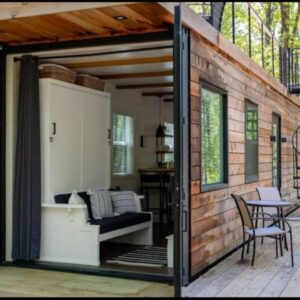Introduction
Urban areas around the world are experiencing rapid population growth, rising property prices, and a demand for sustainable housing alternatives. Traditional construction methods often struggle to meet these challenges due to cost, time, and environmental concerns. Against this backdrop, Shipping Container Homes are emerging as an innovative solution that blends affordability, durability, and eco-friendliness. These modular structures are not just a passing trend; they are shaping the future of urban housing projects in meaningful ways.
This explores how container homes are redefining urban living, their benefits, design potential, and how modifications, including those seen in global hubs like Container Modification Dubai, are influencing modern housing solutions.
Why Urban Housing Needs a Shift
Cities today face multiple challenges:
- High population density putting pressure on limited land.
- Soaring housing costs making homes unaffordable for many.
- Environmental concerns over construction waste and carbon footprints.
- Time constraints in developing large-scale housing projects quickly.
These challenges require a shift in how housing is designed and delivered. This is where shipping container homes step in as a cost-effective, flexible, and sustainable alternative.
What Makes Shipping Container Homes Unique?
Shipping containers are sturdy steel structures originally built to transport goods across oceans. Their durability and modular design make them ideal for conversion into housing. When repurposed, these containers can be transformed into functional living spaces that are:
- Strong and weather-resistant
- Customizable and modular
- Relatively affordable compared to conventional housing
- Eco-friendly since they reuse existing materials
The uniqueness of container homes lies in their versatility. They can serve as single-unit micro homes, multi-story apartments, or even community housing projects.
Container Homes and Sustainable Living
Sustainability is at the core of container housing. Urban development increasingly focuses on reducing waste and carbon emissions, and container homes fit well into this framework.
- Recycling and Reuse: Instead of letting unused shipping containers rust away in ports, they are given a second life as homes.
- Reduced Construction Waste: Building with containers minimizes the debris generated compared to brick-and-mortar construction.
- Energy Efficiency: Containers can be fitted with insulation, solar panels, and smart energy systems to lower utility costs.
- Eco-Friendly Materials: Many container homes integrate green roofing, recycled interiors, and sustainable fittings.
This makes container housing a natural choice for cities aiming to meet green building targets.
The Rise of Container Modification in Urban Projects
One of the most exciting aspects of container housing is modification. Basic steel containers are just the foundation; with the right planning and design, they can be turned into luxurious, comfortable homes.
For instance, regions such as Container Modification Dubai showcase how containers can be adapted to suit urban needs. Whether it’s climate-proofing for hot weather, adding modern interiors, or integrating modular stacking systems, container modification demonstrates the flexibility these structures offer.
Modification also allows for tailored designs such as:
- Multi-story container apartments
- Student housing complexes
- Affordable family homes
- Commercial-residential hybrid spaces
This adaptability ensures that container homes can meet the demands of various urban housing projects.
Benefits of Container Homes for Cities
Container homes offer multiple advantages that make them highly attractive for future urban housing:
- Speed of Construction
Entire units can be prefabricated and installed quickly, making them ideal for large-scale housing projects. - Affordability
The base cost of containers is lower than traditional construction materials, helping reduce housing expenses. - Flexibility in Design
Containers can be stacked, joined, or arranged in creative layouts to fit limited urban spaces. - Mobility
In some cases, container homes can be relocated, offering flexible housing solutions. - Durability
Designed to withstand harsh ocean conditions, containers are naturally resilient against weather and structural stress.
Challenges and Considerations
While container homes hold great promise, urban housing projects must address some key considerations:
- Insulation and Climate Control: Containers need proper insulation to regulate temperature.
- Structural Safety: Cutting into containers for windows and doors requires reinforcement to maintain stability.
- Building Codes and Regulations: Cities must adapt zoning laws to allow container homes as formal housing options.
- Public Perception: Some still view container housing as temporary or low-quality, though modern designs prove otherwise.
By addressing these challenges, cities can integrate container housing more seamlessly into their urban landscapes.
Global Trends Influencing Container Housing
Several global trends are driving the adoption of shipping container homes:
- Affordable Housing Initiatives: Governments and urban planners are seeking cost-effective housing for low and middle-income families.
- Eco-Friendly Architecture: Growing demand for sustainable building solutions positions container housing as a viable choice.
- Urban Minimalism: A cultural shift toward minimalist living aligns with compact container home designs.
- Disaster Relief Housing: Containers can be rapidly deployed to provide shelter in disaster-affected urban areas.
Case for Container Homes in Future Cities
Future urban housing will likely need to be:
- Scalable to meet growing populations
- Affordable for diverse income groups
- Environmentally responsible to align with sustainability goals
- Flexible to adapt to evolving city layouts
Container homes tick all these boxes. They provide a model that is not only cost-effective and eco-friendly but also adaptable to diverse cultural and environmental contexts.
The Urban Aesthetic of Container Homes
Beyond functionality, container homes also bring a unique urban aesthetic that combines modern design with practical living solutions. Contemporary architects are exploring creative ways to integrate container housing seamlessly into cityscapes, resulting in vibrant, livable spaces that are both efficient and visually appealing. Some design innovations include:
- Vertical gardens: Utilizing green walls and rooftop gardens not only enhances the visual appeal but also improves air quality and provides natural insulation, contributing to energy efficiency.
- Rooftop decks: These elevated outdoor spaces create private recreational areas in dense urban environments, allowing residents to enjoy greenery, sunlight, and city views without occupying additional land.
- Glass panels and large windows: Maximizing natural light helps make compact container interiors feel spacious and inviting, while also reducing reliance on artificial lighting.
- Contemporary interiors: Modern layouts, multifunctional furniture, and clever storage solutions allow container homes to rival traditional homes in comfort, style, and functionality.
- Exterior finishes and color palettes: From sleek metallic coatings to eco-friendly paint and natural wood cladding, container homes can match the aesthetic standards of urban neighborhoods.
The combination of these design elements transforms container homes from simple modular units into stylish, adaptable urban residences. They offer a modern living experience that is particularly appealing to younger generations, professionals seeking affordable city housing, and eco-conscious residents looking for sustainable alternatives.
Container Homes and the Future of Housing Policy
As container housing continues to gain popularity, governments and urban planners will need to adapt housing policies to integrate these solutions effectively into city planning. Several steps are crucial:
- Develop building codes specific to container modifications: Standardized regulations ensure that structural safety, insulation, and fire safety meet legal requirements while enabling design creativity.
- Offer incentives for sustainable container-based projects: Tax breaks, grants, or subsidies for projects using recycled containers can encourage developers to adopt eco-friendly housing solutions.
- Encourage mixed-use developments: Combining container homes with commercial spaces, coworking areas, and community amenities can create vibrant, self-sufficient urban neighborhoods.
- Ensure accessibility and affordability across communities: Policies should prioritize equitable housing opportunities to ensure container homes are not limited to niche markets but accessible to a wide range of residents.
- Promote modular urban planning: Supporting modular container neighborhoods allows cities to expand or adapt housing quickly in response to population growth or emergencies.
- Integrate renewable energy and smart solutions: Policies could encourage the use of solar panels, rainwater harvesting, and energy-efficient appliances in container homes to align with broader sustainability goals.
Such policy frameworks will be crucial in making container homes a mainstream part of urban housing strategies. By combining smart design, sustainability, and regulatory support, cities can address housing shortages, reduce environmental impact, and provide affordable yet modern living spaces for their residents.
Conclusion
The role of container homes in future urban housing projects is undeniable. As cities face increasing pressure to provide affordable, sustainable, and flexible housing, shipping containers offer a practical and innovative solution. With advancements in Container Modification Dubai and other global hubs, these homes are moving beyond experimental projects into scalable urban housing strategies.
By embracing container housing, urban planners and communities can look forward to a future where homes are not only accessible and eco-friendly but also creatively designed to fit modern lifestyles.

